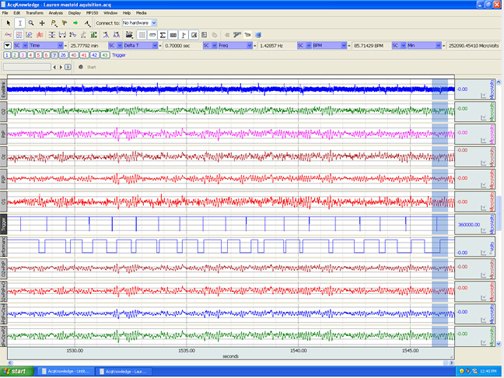UWF Neurocognition Laboratory
The Cognitive Neuroscience Laboratory is under the direction of Dr. James Arruda. Areas of research interest include cyclic variations in attention, mild cognitive impairment, Alzheimer’s dementia, and the multivariate statistics as they are applied to EEG data. The Cognitive Neuroscience Laboratory has a state-of-the-art EEG system (64 channels), including a Scan computer and a Stim2 system.
Research Areas:

Quantitative Electroencephalogram and Sustained Attention
I have worked for several years to develop a quantitative electroencephalographic (qEEG) measure that reliably indexes a sustained attention system within the human brain. We have published numerous articles detailing the psychometric properties of one such qEEG measure and we are moving to confirm the role of the qEEG measure and cortical noradrenaline, a neurotransmitter, in the sustained attention process. (Valentino et al., 1993; Arruda et al., 1996; Costa et al., 1997; Arruda et al., 1999; Smith et al., 2002; Smith et al., 2003; Arruda et al., 2007; Arruda et al., 2009, and Aue et al., 2009).
Because the identified attention system is believed to be dependent upon ascending noradrenergic fibers, we are currently contemplating the use of a noradrenaline reuptake inhibitor that we believe would improve the behavioral performance of participants and produce a corresponding increase in the activity of the identified qEEG measure. If true, these findings would further support the posited role of noradrenaline in the sustained attention process and validate the identified qEEG measure as a reliable and valid index of noradrenergic (sustained attention) processing.
Flash Visual Evoked Potential P2 and Alzheimer's Dementia
Researchers have demonstrated repeatedly that the flash visual evoked potential P2 (FVEP-P2), a positive-going brain wave resulting from a strobe flash, is selectively delayed in groups of Alzheimer patients, compared to groups of healthy controls of the same age. These robust, between-group differences suggest that some aspects of the FVEP-P2 delay are specific to Alzheimer's disease, and that the P2, an index of cholinergic functioning, could be used diagnostically. Unfortunately, researchers have been unable to take the next step and demonstrate that the FVEP-P2 delay can accurately separate individuals into Alzheimer and non-Alzheimer groups. Indeed, our own laboratory assessed the diagnostic accuracy of the FVEP-P2 and found that the diagnostic accuracy was too low for the FVEP-P2 to be used for clinical purposes (Coburn et al., 2003).
Given the current state of research on the FVEP-P2, it has become apparent that further development of the FVEP-P2 is necessary. We suspect that the poor diagnostic accuracy stems from two sources: either the flash stimulus intensity was not optimal or the electrode sites chosen were unreliable. To address these potential problems we assessed the test-retest reliability of the FVEP-P2 produced by five different flash intensities over a much larger area of the brain. The results of this investigation suggest that the most reliable FVEP-P2 waveform comes from visual cortex within the occipital lobe an area referred to as O2 (Coburn et al., 2005). This particular site produced FVEP-P2 waveforms with amplitudes and latencies that were reliable across all five of the stimulus intensity conditions.
The results of this investigation have allowed us to reexamine the clinical utility of the FVEP-P2 in the diagnosis of Alzheimer's dementia. Given the documented reliability of the FVEP-P2 when measured from the O2 electrode-recording site, we believe the between-group differences seen previously may become large enough to allow for the discrimination of individual Alzheimer patients from healthy, age-matched controls. Indeed, we are now completing an investigation that was funded by the Byrd Institute that will allow us to assess the clinical utility of the FVEP-P2 in diagnosing mild cognitive impairment an early stage of Alzheimer's dementia.
Principal Component Analysis, Quantitative Electroencephalogram, and Sample Size
Principal component analysis (PCA) is a descriptive, multivariate procedure that is often used to meaningfully reduce of a large set of measured variables to a smaller set of component variables. The components produced by a PCA represent latent constructs that can be measured by linearly combining a correlated subset of the original measured variables. When used with qEEG, a PCA may assist in the identification and measurement of neurocognitive systems within the human brain.
Despite its potential usefulness in model building, the use of PCA with qEEG can be challenging due to the sample sizes required for the PCA, which may exceed 300 participants. Assuming that it takes several hours to collect the qEEG from a single participant, it may become prohibitive to conduct qEEG research when PCA is involved. To address this issue, we are now conducting a series of simulation studies designed to assess the effects of sample size on PCA solution accuracy. We have designed the simulations to take into account the statistical characteristics of actual qEEG data (Arruda et al., in press) and we are hopeful that the results of the simulation studies will support the use of much smaller sample sizes.




